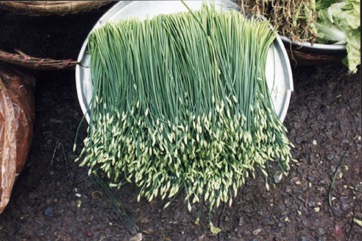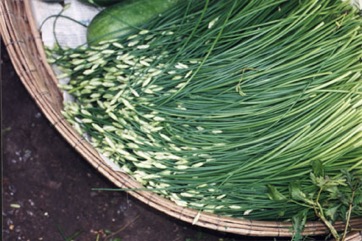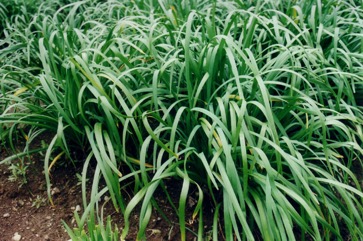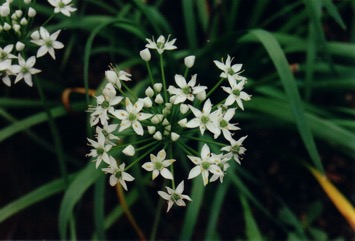Garlic chives, Chinese chives

A temperate plant. They are native to eastern Asia. Seeds are rarely formed in the lowland tropics. It is naturalised in S China. In Indonesia it grows up to 2,200 m above sea level. It suits hardiness zones 7-10. In Yunnan.
Also known as:
Amput di imayyaw, Bawang Kuchai, Buchu, Bunga-ghundeena, Cuchay chives, Flowering chives, Ganda, Gau choy, Guichai, Gyu-myit, He, Hom-paen, Jirlang, Jiu Cai, Kachaay, Kau, Kau ts'oi, Koo chye, Kuchai, Kui chaai, Kutsay, La he, Nira, Oriental garlic, Tareh, Tsoi, Yellow chives
Synonyms
- Allium argyi H.Leveille
- Allium chinense Maxim (1859) not G.Don (1827)
- Allium clarkei J.D.Hooker
- Allium roxburghii Kunth.
- Allium senescens Miq.
- Allium sulvia Buch.-Ham.ex D.Don
- Allium tuberosum Roxb.(1832) Allium uliginosum G. Don not Ledebour
- Allium yesoense Nakai
- Allium odoratum auct. non L.
- Allium bakeri auct. non Regel.
Edible Portion
- Flowers, Leaves, Root, Bulb, Herb, Vegetable
Where does Garlic chives grow?
Found in: Asia, Australia, Cambodia, Canada, China, Cook Islands, Cuba, East Timor, Fiji, Haiti, Hawaii, Himalayas, India, Indochina, Indonesia, Japan, Korea, Malaysia, Marshall Islands, Micronesia, Mongolia, Myanmar, Nauru, Nepal, North America, Northeastern India, Pacific, Papua New Guinea, PNG, Philippines, SE Asia, Singapore, Slovenia, Taiwan, Tasmania, Thailand, Timor-Leste, Tuvalu, United States, Vanuatu, Vietnam
Notes: There are about 300-700 Allium species. Most species of Allium are edible (Flora of China). All alliums are edible but they may not all be worth eating! They have also been put in the family Alliaceae.
Status: It is cultivated as a vegetable. It is a commercially cultivated vegetable.
Growing Garlic chives, Chinese chives
Cultivation: Plants can be grown by dividing the clump of plants or by seed. Seed production is not easy. Plants are sown in rows 30 cm apart.
Edible Uses: The leaves and young flowers are used to flavour foods. The bulbs are used like garlic.
Production: Chives may be cultivated for its flowers which are plucked together with the stalks before the buds emerging from the sheath. They can also be grown for its edible leaves which have a special flavour considered fragrant by some people.
Nutrition Info
per 100g edible portion| Edible Part | Energy (kcal) | Protein (g) | Iron (mg) | Vitamin A (ug) | Vitamin c (mg) | Zinc (mg) | % Water |
|---|---|---|---|---|---|---|---|
| Bulb | - | - | - | - | - | - | |
| Flowers | - | - | - | - | - | - | |
| Leaves | - | 2.1 | - | - | 25 | - | 93 |
Garlic chives, Chinese chives Photos




References
Aballe, K. E., 2012, Ethnobotanical Investigation of Matigsalug Ethnic Group in Sitio Patag, Brgy. Datu Salumay, Marilog District, Davao City. University of Southeastern Philippines. Part 2 p 21
Altschul, S.V.R., 1973, Drugs and Foods from Little-known Plants. Notes in Harvard University Herbaria. Harvard Univ. Press. Massachusetts. no. 270
Anderson, E. F., 1993, Plants and people of the Golden Triangle. Dioscorides Press. p 202
Barrau, J., 1976, Subsistence Agriculture in Melanesia. Bernice P. Bishop Museu, Bulletin 219 Honolulu Hawaii. Kraus reprint. p 55
Bremness, L., 1994, Herbs. Collins Eyewitness Handbooks. Harper Collins. p 142
Brickell, C. (Ed.), 1999, The Royal Horticultural Society A-Z Encyclopedia of Garden Plants. Convent Garden Books. p 98
Brown, D., 2002, The Royal Horticultural Society encyclopedia of Herbs and their uses. DK Books. p 114
Burnie, G & Fenton-Smith, J., 1999, A Grower's Guide to Herbs. Murdoch Books. p 24
Cheifetz, A., (ed), 1999, 500 popular vegetables, herbs, fruits and nuts for Australian Gardeners. Random House p 113
Chen Xinqi, Liang Songyun, Xu Jiemei, Tamura M.N., Liliaceae. Flora of China. p 110
Chin, H. F., 1999, Malaysian Vegetables in Colour. Tropical Press. p 34
"Chinese Nutrition Journal", 2002, Vol 23(8) p 298
Crawford, M., 2012, How to grow Perennial Vegetables. Green Books. p 106
Creasy, R., 2000, The Edible Asian Garden. Periplus p 43
Cundall, P., (ed.), 2004, Gardening Australia: flora: the gardener's bible. ABC Books. p 128
Ethnobotany of Karbis. Chapter 4 in p 106
Facciola, S., 1998, Cornucopia 2: a Source Book of Edible Plants. Kampong Publications, p 7
Flora of China. www.eFloras.org
Foo, J.T.S.(ed), 1996, A Guide to Common Vegetables. Singapore Science Foundation. p 112
French, B., 1986, Food Plants of Papua New Guinea, Asia Pacific Science Foundation p 128
Gouldstone, S., 1983, Growing your own Food-bearing Plants in Australia. Macmillan p 188
Hani Medicine of Xishuangbanna, 1999, p 619
Hutton, W., 1997, Tropical Herbs and Spices of Indonesia. Periplus. p
Hu, Shiu-ying, 2005, Food Plants of China. The Chinese University Press. p 315
Jacquat, C., 1990, Plants from the Markets of Thailand. D.K. Book House p 102
Jiwajinda, S., et al, 2002, Suppressive Effects of Edible Thai Plants on Superoxide and Nitric Oxide Generation. Asian Pacific Journal of Cancer Prevention, Vol 3, 2002
Kang, Y., et al, 2012, Wild food plants and wild edible fungi in two valleys on the Qinling Mountains (Shaanxi, central China) Journal of Ethnobiology and Ethnomedicine; 9:26
Kays, S. J., and Dias, J. C. S., 1995, Common Names of Commercially Cultivated Vegetables of the World in 15 languages. Economic Botany, Vol. 49, No. 2, pp. 115-152
Kiple, K.F. & Ornelas, K.C., (eds), 2000, The Cambridge World History of Food. CUP p 1755
Larkcom, J., 1991, Oriental Vegetables, John Murray, London, p 71
Lazarides, M. & Hince, B., 1993, Handbook of Economic Plants of Australia, CSIRO. p 14
Lim, T. K., 2015, Edible Medicinal and Non Medicinal Plants. Volume 9, Modified Stems, Roots, Bulbs. Springer p 6
Liu, Yi-tao, & Long, Chun-Lin, 2002, Studies on Edible Flowers Consumed by Ethnic Groups in Yunnan. Acta Botanica Yunnanica. 24(1):41-56
Martin, F.W. & Ruberte, R.M., 1979, Edible Leaves of the Tropics. Antillian College Press, Mayaguez, Puerto Rico. p 105
McCollum, G.D., 1979, Onions and allies, in Simmonds N.W.,(ed), Crop Plant Evolution. Longmans. London. p 186
Miguel, E., et al, 1989, A checklist of the cultivated plants of Cuba. Kulturpflanze 37. 1989, 211-357
Norrington, L., & Campbell, C., 2001, Tropical Food Gardens. Bloomings Books. p 62
Plants for a Future database, The Field, Penpol, Lostwithiel, Cornwall, PL22 0NG, UK. http://www.scs.leeds.ac.uk/pfaf/
PROSEA handbook Volume 13 Spices. p 273
Purseglove, J.W., 1972, Tropical Crops. Monocotyledons. Longmans p 56
Rana, J.C. et al, 2011, Genetic resources of wild edible plants and their uses among tribal communities of cold arid regions of India. Genetic Resources and Crop Evolution. 59:135-149
Schneider, E., 2001, Vegetables from Amaranth to Zucchini: The essential reference. HarperCollins. p 297
Siemonsma, J. S. and Piluek, K. (Eds), 1994, Plant Resources of South-East Asia No. 8 Vegetables. Prosea Foundation, Bogor, Indonesia, p 80
Solomon, C., 2001, Encyclopedia of Asian Food. New Holland. p 95
Song, M., et al, 2013, Traditional knowledge of wild edible plants in Jeju Island, Korea. Indian Journal of Traditional Knowledge. 12(2) pp 177-194
Staples, G.W. and Herbst, D.R., 2005, A tropical Garden Flora. Bishop Museum Press, Honolulu, Hawaii. p 681 (Drawing)
Syst. veg. 2:38. 1825
Tanaka, Y. & Van Ke, N., 2007, Edible Wild Plants of Vietnam: The bountiful garden. Orchid books. p 18
Teron, R. & Borthakur, S. K., 2016, Edible Medicines: An Exploration of Medicinal Plants in Dietary Practices of Karbi Tribal Population of Assam, Northeast India. In Mondal, N. & Sen, J.(Ed.) Nutrition and Health among tribal populations of India. p 152
Terra, G.J.A., 1973, Tropical Vegetables. Communication 54e Royal Tropical Institute, Amsterdam, p 20
Thaman, R. R., et al, 1994, The Flora of Nauru. Atoll Research Bulletin No. 392. Smithsonian Institute p 55
Thaman, R. R, 2016, The flora of Tuvalu. Atoll Research Bulletin No. 611. Smithsonian Institute p 35
Thomson, G. & Morgan, W., (Ed.) 2001, Access to Asian Foods Newsletter, Vic Govt., Australia Issue 36
Tindall, H.D., 1983, Vegetables in the tropics. Macmillan p. 30
Urgamal, M., et al, 2014, Conspectus of the Vascular Plants of Mongolia. Mongolia Academy of Sciences Institute of Botany and National University of Mongolia Department of Biology. p 48
USDA, ARS, National Genetic Resources Program. Germplasm Resources Information Network - (GRIN). [Online Database] National Germplasm Resources Laboratory, Beltsville, Maryland. Available: www.ars-grin.gov/cgi-bin/npgs/html/econ.pl (10 April 2000)
Vander Velde, N, 2003, The Vascular Plants of Majuro Atoll, Republic of the Marshall Islands. Atoll research Bulletin. No. 503. Smithsonian Institute. p 21
van Wyk, B., 2005, Food Plants of the World. An illustrated guide. Timber press. p 53
Vermeulen, N, 1998, The Complete Encyclopedia of Herbs. Rebo Publishers. p 38
Walter, A. & Lebot, V., 2007, Gardens of Oceania. ACIAR Monograph No. 122. p 223
Wild edible plants of Himachal Pradesh
Woodward, P., 1996, Garlic and Friends. The History, Growth and Use of Edible Alliums. Hyland House. p 61
Woodward, P., 2000, Asian Herbs and Vegetables. Hyland House. p 17
World Checklist of Useful Plant Species 2020. Royal Botanic Gardens, Kew
Zhang, L., et al, 2016, Ethnobotanical study of traditional edible plants used by the Naxi people during droughts. Journal of Ethnobiology and Ethnomedicine. 12:39